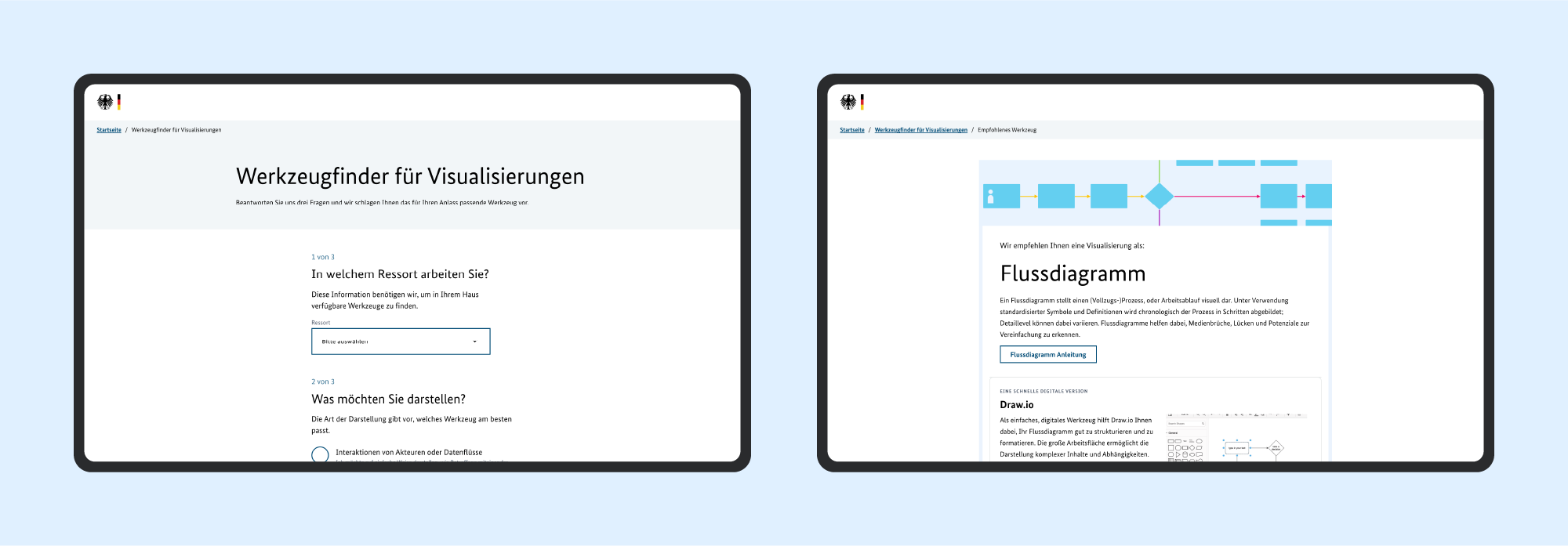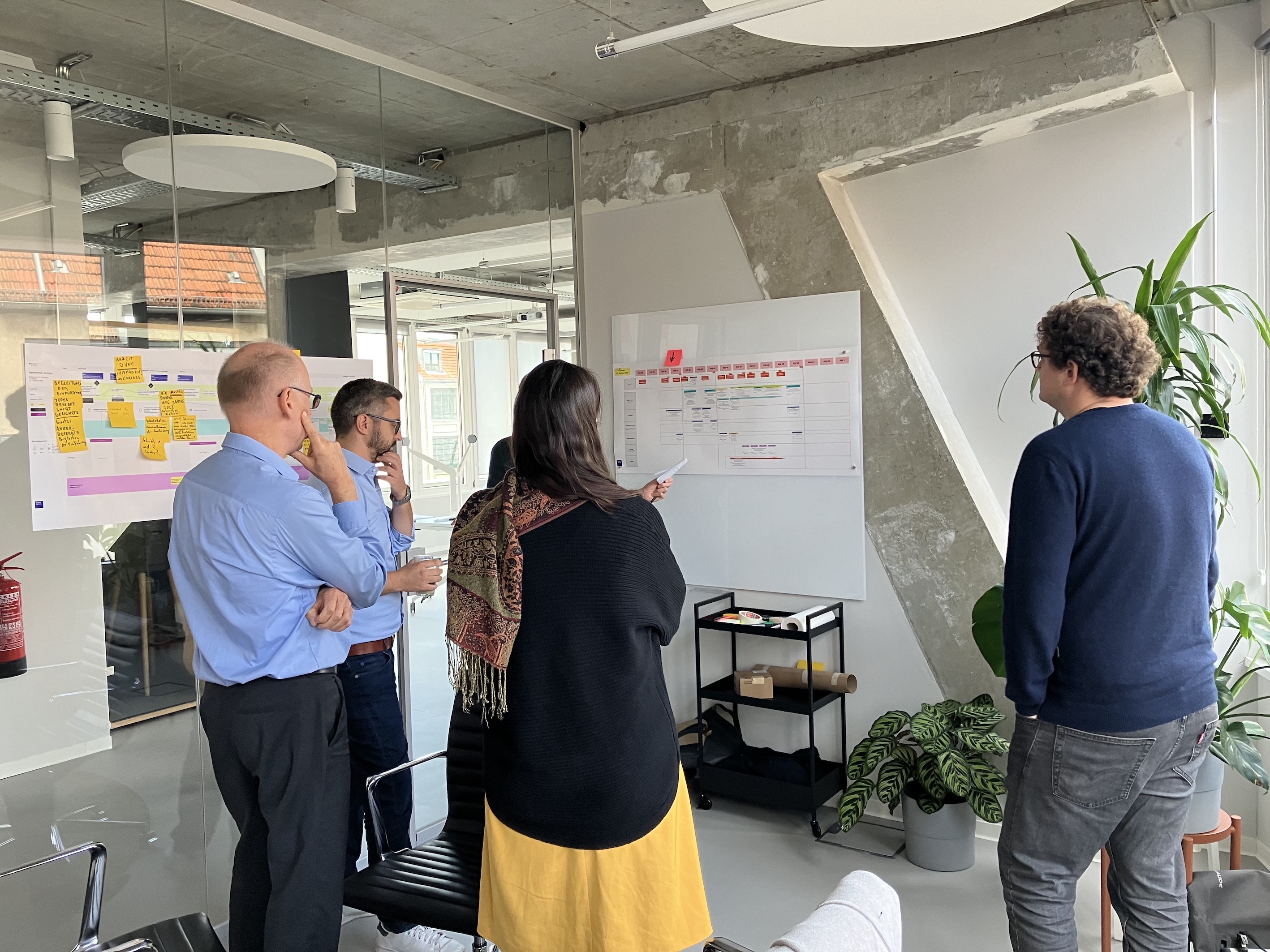

How we will continue to develop Digitalcheck in 2024
Digitalcheck is one of five “rising stars” and is considered an “important topic with growing relevance”, according to the Behörden Spiegel newspaper, Kompetenzzentrum Öffentliche IT (Competence Center Public IT / ÖFIT), and Fraunhofer Fokus in their ThemenRadar (topic radar) of Public Administration 2024 (German only).This blog post shows how we plan to further develop the rising star Digitalcheck over the course of the year.
It also addresses why digital-ready legislation is a longer-term mission that will extend even beyond 2024, and why achieving the ongoing further development and evolution that the German federal cabinet identified as goals in August 2023 will require this to be made a lasting reality.
Working in tandem, the German Federal Ministry of the Interior and Community (BMI) and DigitalService have laid the groundwork for a productive year in 2024. Our blog post One year in: Digitalcheck has become established offers a good overview of what we have achieved so far.
Our goals for 2024
Last year, we gleaned important insights into the opportunities and obstacles associated with digital-ready legislation from a variety of data sources. Building on these findings, we crafted objectives and prospective solutions and evaluated and prioritized them with an eye to their effectiveness, the significance of our data sources, and feasibility. Examples include working with visualizations and assigning an interdisciplinary task force to support individual pieces of legislation.
Alongside fundamental parameters such as the current budgetary situation, two factors were especially important when we were making our plans for 2024. First, whether funding will be available for Digitalcheck in 2025, and if so how much, will not be clear until the final federal budget is adopted for 2025. Second, the end of the current legislative period is approaching with the Bundestag elections in September 2025. This means that important initiatives will be concluded, and the German federal government’s future political agenda will not be set until a new coalition agreement is reached. It is already clear that the legal mandate of the National Regulatory Control Council (NKR) to carry out an audit will make Digitalcheck a permanent task for the federal government.
Against this background, we have prioritized the following goals for our ongoing development this year:
Goal 1: Ensure that Digitalcheck is effective and can create lasting value – even if there are no additional resources for further development and support from 2025 onward
The focus here is on further developing the methodological process support that Digitalcheck offers for policy drafters. Alongside improvements and additions to the content, this also relates to how content is prepared and delivered. One key question, for example, is whether the current PDF-based version of Digitalcheck can be supplemented or entirely replaced by digital tools.
Goal 2: Create value for and with policy drafters through visualization and by incorporating expertise on digital implementation
We plan to work swiftly to develop and test digital tools that make it easier for policy drafters to work with visualizations. Our first digital tool is already live: a prototype tool finder that offers recommendations for suitable notations and visualization tools available at specific ministries. This will give us valuable insight into the effectiveness and use of the tool in real-world practice.
It is also important to ask how we can include the stakeholders involved in implementing laws – at the municipal and government agency levels, for example – earlier and more effectively in the process of drafting of new regulations in an effort to improve the digital feasibility of those regulations.
We also plan to continue to test the use of an interdisciplinary task force comprising specialists from the fields of software development, design, and product management within the scope of concrete legislative initiatives.

The tool finder gives policy drafting personnel recommendations for the right kind of visualization and the tools available at their specific ministry.
Goal 3: Highlight the impact of digital-ready legislation
Alongside our goals for direct further development, this year we will also be focusing on highlighting the impact of digital-ready legislation. We plan to use concrete examples to show the value that digital-ready legislation adds for government agencies, constituents, and businesses alike – through aspects such as simpler processes, streamlined workflows, and thus less bureaucratic red tape. We hope this will bring us important insight to help guide our own development while also raising awareness of the tremendous importance of this subject.
Goal 4: Craft a plan to make digital-ready legislation a lasting reality
Beyond specific actions to further develop Digitalcheck, we will also be working in 2024 to make the various measures put in place for digital-ready legislation a lasting reality. What measures and support options should be continued? What requirements will establishing this lasting reality entail? How can we partner with other stakeholders working toward improved and digital legislation to put lasting structures in place?
Lasting digital-ready legislation is a long-term task
The Digitalcheck is a key element in digital-ready legislation. But the bigger-picture vision behind it points to a more sweeping goal: improving the effectiveness of political initiatives while systematically trimming bureaucracy. Achieving these twin aims will require further steps. Important topics include:
- What form might a digital legislative cycle take in optimally integrating the needs and requirements of all stakeholders involved, from legislation to implementation and through to case law? How can digitalization enhance transparency and involvement in structural terms across the entire legislative cycle, from the political initiative and drafting to the parliamentary process and through to implementation, evaluation, and ultimately the courts? Based on central projects such as the E-Gesetzgebung (electronic legislation) and E-Verkündung (electronic announcement) initiatives and the NeuRIS legal information system, the objective here is to harness this potential for various target groups. The joint GovLabDE project, which aims to arrive at an overall objective for digitalization of legislation at the federal level, offers an important basis here.
- How can visualizations and modeling be used systematically across the entire digital legislative cycle toward objectives such as simpler digital implementation and improved understanding of complex regulatory contexts? How can policy drafters build on visualizations of the existing process when laws are amended?
- How can the existing expertise of those involved in implementation be incorporated more effectively on a broad basis and used to systematically improve regulation and reduce bureaucracy (ex ante) in the legislative cycle, beyond rules such as “one in, one out”?
- How can the work of policy drafters be facilitated at the structural level, with better institutional support, and how can the many different guidelines and requirements with regard to areas such as regulatory impact assessments be consolidated? What role could the Zentrum für Legistik at the German Federal Ministry of Justice (BMJ) play in this going forward, as the central body responsible for qualification and research on matters of practical legislation?
- How can not only new laws, but also existing legislation, be made more practical and digital-ready? This is important because when a new law is introduced, it often touches on other regulations, or there may be laws in place that affect its implementation, and these should also be considered – but are seldom addressed systematically as part of the specific reform or amendment project. The practical check developed by the German Federal Ministry for Economic Affairs and Climate Action (BMWK) provides a valuable approach here, especially with an eye to cooperation among various regulatory levels within the federal structure. How can this approach be scaled and institutionalized as part of the legislative cycle?
All this means there is still a ways to go in making digital-ready legislation a lasting reality. Digitalcheck needs to go from being a rising star to a mainstay in the system. But above all, it – and the other projects under way in the context of modern legislation – must be embedded in a holistic long-term structure geared toward improved, practical, and digital-ready legislation.
Read more on the topic






